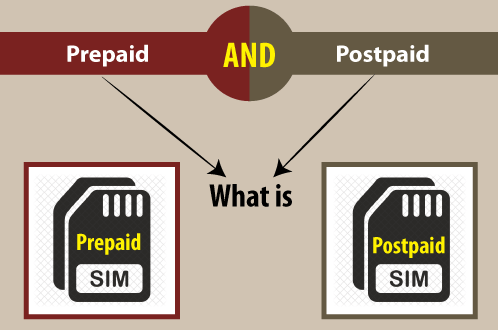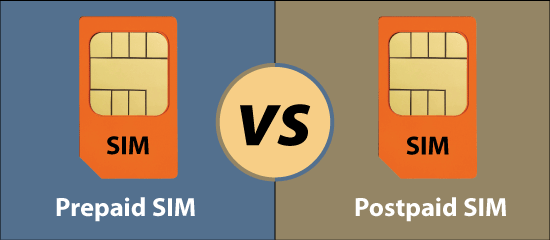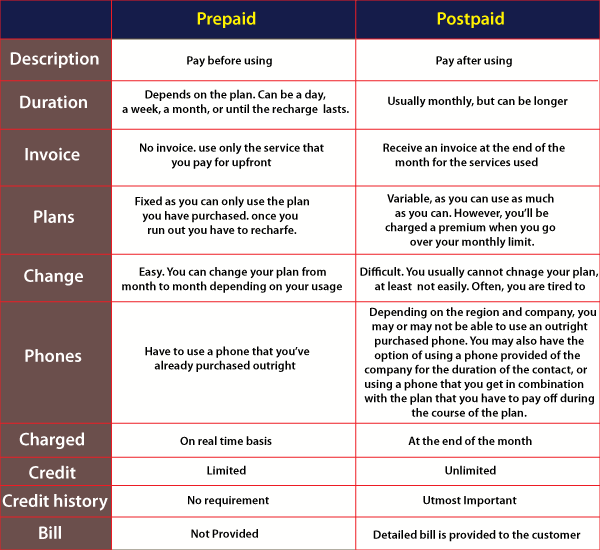Different between Prepaid and PostpaidWhen prepaid and postpaid connections are discussed, there is always a buzz. As the term hints, Prepaid refers to payments received in advance for the later use of utilities. On the other side, postpaid is when you use the utilities first and then pay for them. 
Specialists, employers, and members of the corporate class favor postpaid over prepaid, while among teenagers prepaid is preferable to postpaid. As a result, the fight between such two SIMs (Subscriber Identity Modules) never ends. People are sometimes bewildered which association is superior to another. Go through the post to discover further about the differences between prepaid and postpaid services. PrepaidA prepaid connection or service is described as a connectivity that is paid for in advance. Prepaid, which means prepayment, is a form of mobile link you pay in advance for services such as texting, internet access, and other features. The customer spends credit before accessing the facilities in this package. To use a specific program, you must first recharge the SIM, and then you can use it before the credit runs out or the period under which the recharge expires (whichever is prior). You will no longer be eligible to access the programs until the service is recharged. You can top up your account again if you have consumed all data or minutes before the expiration of validity. So, it allows consumers to recharge their credit at any moment. A prepaid cell phone contract is the one in which you pay the operator a certain fee upfront, which is the cell credit that you can use for calls, emails, mobile data, and more. Some data plans have a guaranteed number of call time and text messages, whereas others provide unlimited calls and SMS, and even some include pay-as-you-go (PAYG) plans, which bills you only for minutes, texts, or megabytes you use. Prepaid plans with free minutes and texts are becoming the most prominent. Prepaid plans are standard for consumers who choose to pay for their service upfront rather than incurring more costs or being surprised by their payment at the end of each month. One disadvantage is that if you don't use the benefits completely before the end date (usually 28-30 days) or before the plan expires, you will end up paying more each year than a postpaid contract. PostpaidA postpaid link is described as a connection that is not prepaid. The term "postpaid" refers to a SIM card that allows you to pay for your service after you have used them. The client will access the services of the telephone network with a mobile connection. Then he is charged at the end of each month or billing period or according to their arrangement with the service supplier. Usually, the user pays according to his network supplier's agreement, which outlines the number of minutes for searching, texting, and calling. According to their consumption, the customer is charged a flat rate that can be less than or equal to the prescribed amount. Any use over this is subjected to more fees. It's also possible to say that the customer can avail the credit. The client's credit history is critical in a postpaid service because it serves as a foundation for the provider to determine whether the consumer can cover the unpaid bill amount or not. The contract stipulates that the service provider may pursue civil action against the consumer if the bill is not paid. A postpaid cell phone contract requires you to pay a flat monthly fee in return for a certain number of calls, emails, and data used during the billing cycle. The concept behind retro charging encourages people to go over their plan's limits if necessary and pay for it later. It means you can still use your mobile, even though you've used up your monthly allowance. Furthermore, postpaid agreements are available in four services of different duration such as monthly, 12 months, 24 months, and sometimes 36 months. Which is less expensive a prepaid or a postpaid sim?When we analyze the policies and services offered on prepaid and postpaid SIM, it is evident that prepaid SIM is less expensive, while postpaid SIM has some extra services for which you may have to charge extra. When we buy a prepaid plan, GST is included in the price, while when we buy a postpaid plan, we must pay GST on top of the price. In India, mobile networks are reportedly subject to an 18 percent GST. If we buy a 299 prepaid package from a telecommunication company, we have to pay 299. But if we pick the 299 plan in postpaid, we will have to pay an extra 18 percent GST on top of the 299, so we will have to pay about 350 in postpaid. Benefits:
The difference between billing models of PREPAID and POSTPAID?
A PREPAID strategic priority is paying in advance for services. If your checking account falls below a certain threshold, the billing system immediately suspends the services. This payment model is comparable to a PREPAID telephone contract, in which you can only send and accept calls if your SIM card checking account is enough. The service provider also allows to set up automated top-ups on your budget to pay for a downtime caused by a negative checking account. As opposed to PREPAID, POSTPAID is a payment model in which you pay after you use the service. On the first calendar day itself, you would be sent an invoice for the prior month's product use and maintenance charges; you will only have 14 days to collect the invoice. A completely refundable down payment equal to one month's service use and subscription is needed to move to a POSTPAID billing model. Let's look at prepaid connections, where you have to pay upfront to use the utilities. After recharging the plan, you are free to access all programs and incentives. You can refill the plan if needed. Furthermore, prepaid plans allow you to select many packages at once, such as limited top-ups, data bundles, job packs, add-on validity, and more. All you have to do is choose a package that meets your needs, and several telecom providers, including Airtel, Vodafone-Idea, Reliance Jio, MTNL, and BSNL, provide these plans. On the other side, if you opt for postpaid options, you must pay the bill after using facilities each month. These services are available for monthly rental and are enabled every month. Extra services are also available in postpaid plans and accordingly the bill is generated. Key Differences:Prepay and post-pay terms for mobile phone connections are the mostly used terms. The word PRE-paying means payable before use, while POST-paying means payment after using. The words prepayment and post-payment are used in conjunction with requested networks, such as cell telephones, Internet accesses, cable connections, etc. The words are mostly used for smartphone or cell phone links. You may also apply for credit card prepayment and post-payment. 
Each connection has different advantages and disadvantages.A disadvantage of prepaid is that the customer has to pay early. The advantages are that in comparison to postpaid payments, they don't pay the undisclosed charges and other benefits that are often added to the invoice. They use only the facilities for which they are paying. Another advantage of prepayment is that you can still adjust the plan. If the policy is complete, you can choose another one that has more or less value. E.g., if your minutes of calls are consumed, you can buy fewer minutes before the plan comes to an end. It is not available in postpaid payment since there are always cancellation charges in the arrangements to change the plans. Even to change the plan, you have to give a proper logical explanation. So, it is not simple to change the postpaid plans. The other advantage of prepaid is that you can use the prepaid program only when you need it, such as for one month or several months, etc. Post payment has no such freedom. It usually needs a pledge for one year or more, and it is impossible to get out of the deal. In contrast, the fact that you need to keep track of your minutes is a downside to the prepayment. Since you can only use what you have already paid for, you don't want to finish up all the minutes. In post payments, you hardly come across this case because you will continue using minutes and information even after using your allocated minutes and data. Furthermore, prepaid offers different packages for each service, such as in wireless subscriptions one for calling minutes and another for data, SMS, etc. Postpaid provides combined use. You can use different services in one plan and pay for them in the same bill at the end of the month. The postpaid contracts in some areas allow the opportunity to have the telephone at a reduced rate. This promotion is very uncommon in prepayments, and you need to buy your telephone to use. So, we can say that both prepayment and post-payment are substantial. One can choose according to his or her requirements as it is dependent on consumer choices and desires, as mentioned above. For example, you can choose the Postpaid if you can also pay extra for small usages, then there is no pain.
Next TopicDifference between
|
 For Videos Join Our Youtube Channel: Join Now
For Videos Join Our Youtube Channel: Join Now
Feedback
- Send your Feedback to [email protected]
Help Others, Please Share










